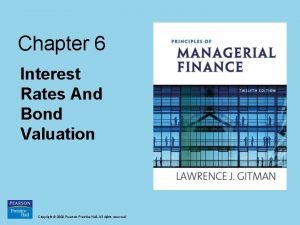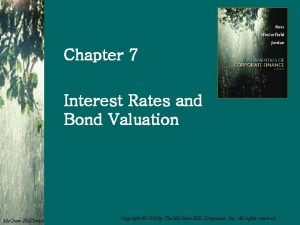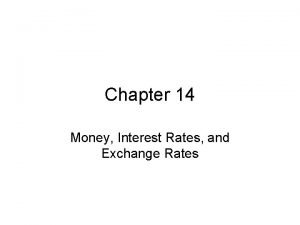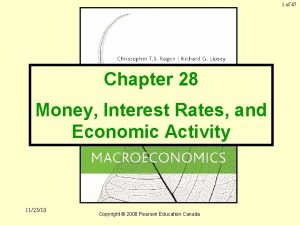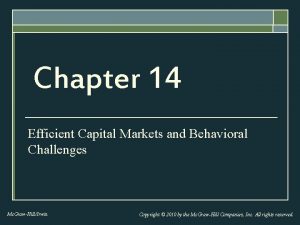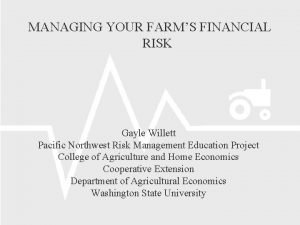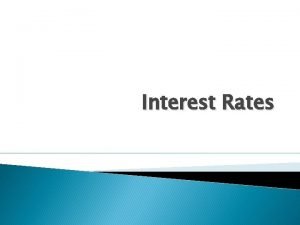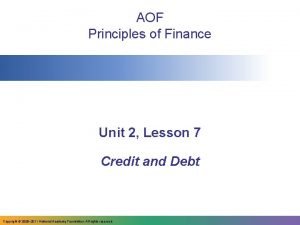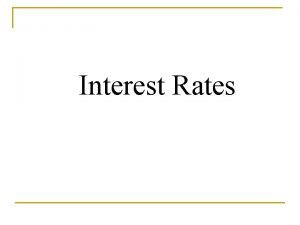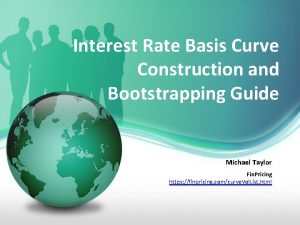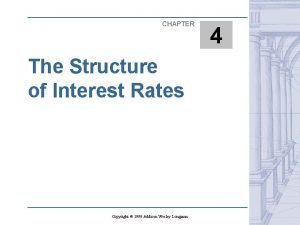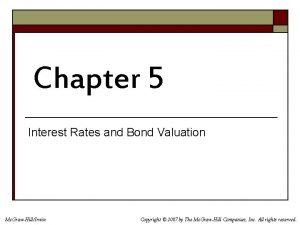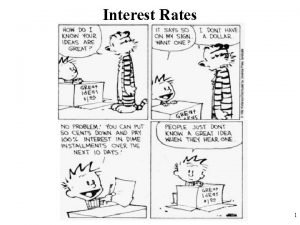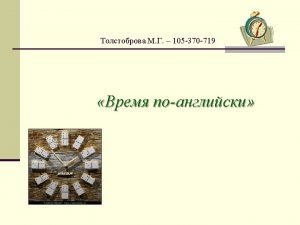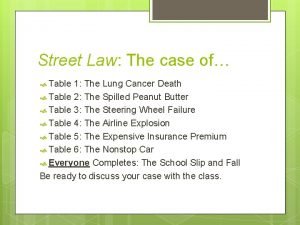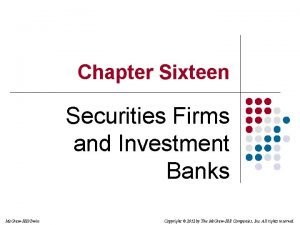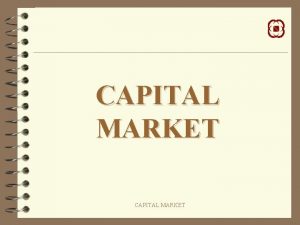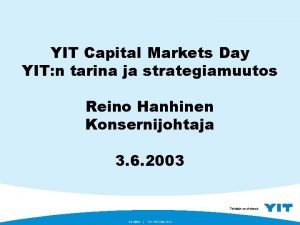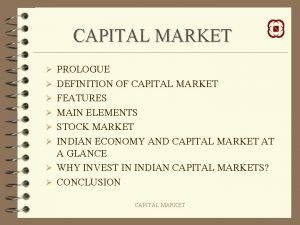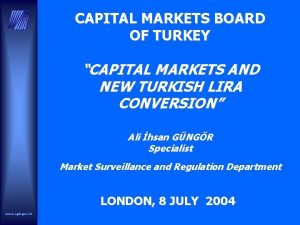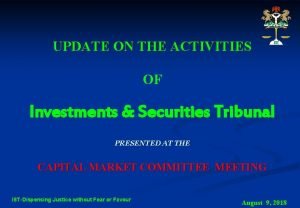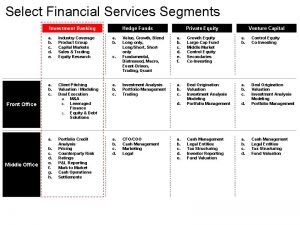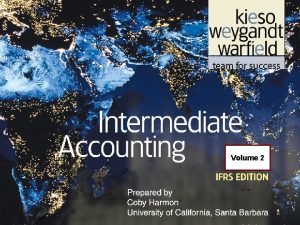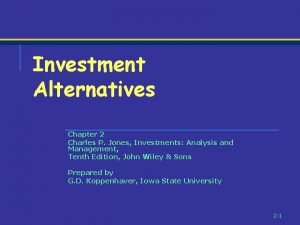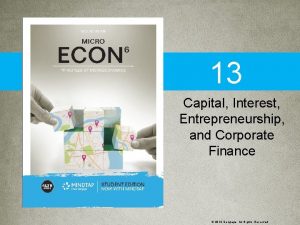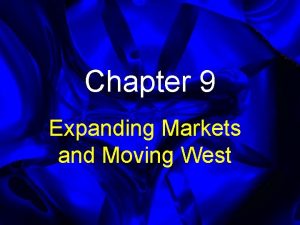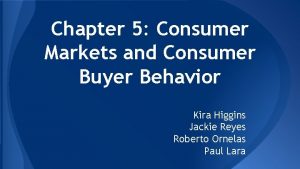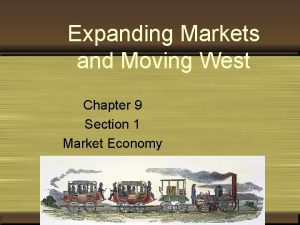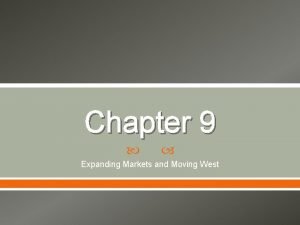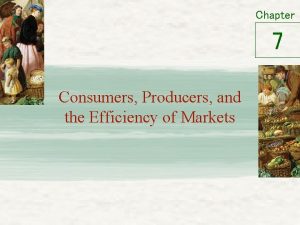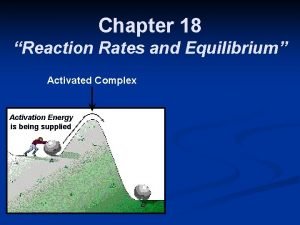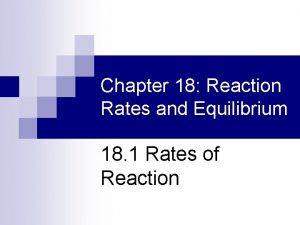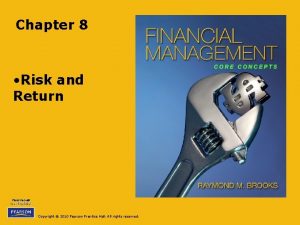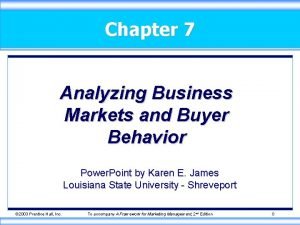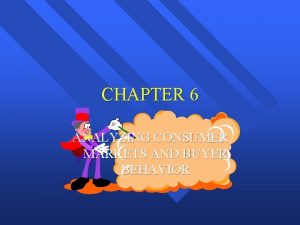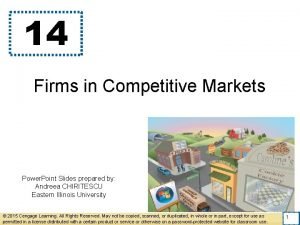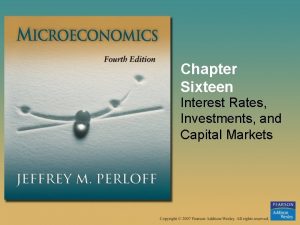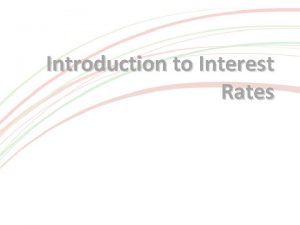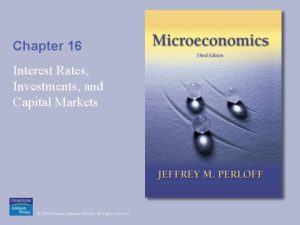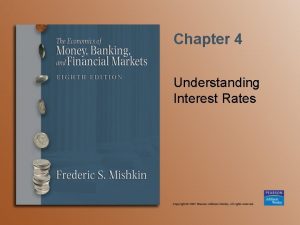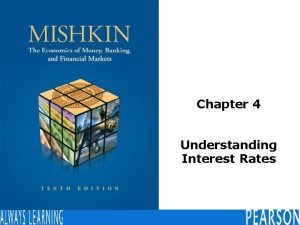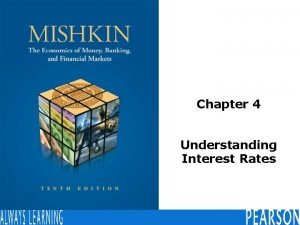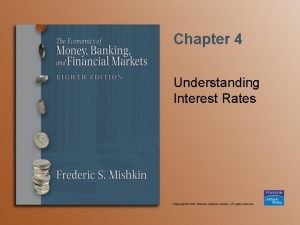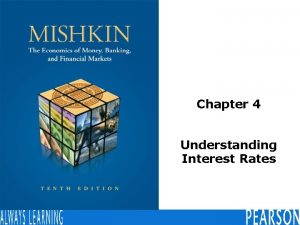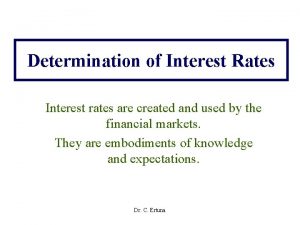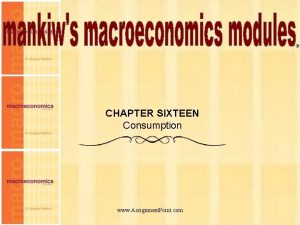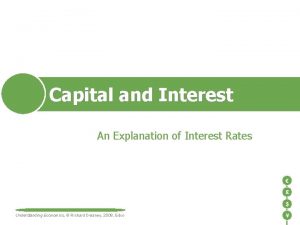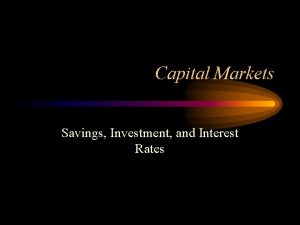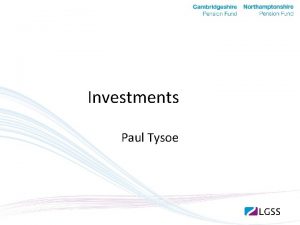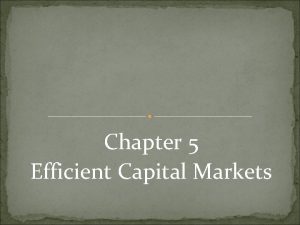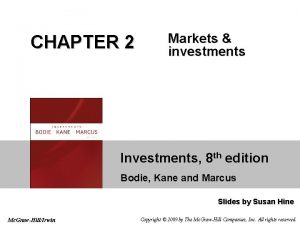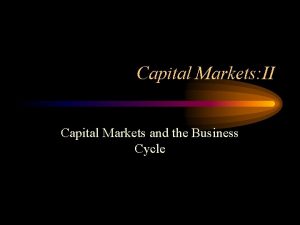Chapter Sixteen Interest Rates Investments and Capital Markets








































































- Slides: 72

Chapter Sixteen Interest Rates, Investments, and Capital Markets

Topics § Comparing Money Today to Money in the Future. § Choices over Time. § Exhaustible Resources. § Capital Markets, Interest Rates, and Investments. © 2009 Pearson Addison-Wesley. All rights reserved. 2

Introductory Definitions § durable goods - products that are usable for years. § stock - a quantity or value that is measured independently of time. § flow - a quantity or value that is measured per unit of time © 2009 Pearson Addison-Wesley. All rights reserved. 3

Interest Rates § interest rate - the percentage more that must be repaid to borrow money for a fixed period of time © 2009 Pearson Addison-Wesley. All rights reserved. 4

Discount Rate. § discount rate - a rate reflecting the relative value an individual places on future consumption compared to current consumption. § If your discount rate is nearly zero w you would gladly loan money in exchange for a positive interest rate. § if your discount rate is high w you would be willing to borrow at a lower interest rate. © 2009 Pearson Addison-Wesley. All rights reserved. 5

Compounding. § If you place $100 in a bank account that pays 4%, w at the end of a year, you can take out the interest payment of $4 and leave your $100 in the bank to earn more interest in the future. © 2009 Pearson Addison-Wesley. All rights reserved. 6

Compounding (cont). § If you leave your $100 in the bank indefinitely and the interest rate remains constant over time, w you will receive a payment of $4 each year. w In this way, you can convert your $100 stock into a flow of $4 -a-year payments forever. © 2009 Pearson Addison-Wesley. All rights reserved. 7

Compounding (cont). § if you leave both your $100 and your $4 interest in the bank, w The bank must pay you interest on $104 at end of the second year. w The bank owes you interest of $4 on your original deposit of $100 w and interest of $4 × 0. 04 = $0. 16 on your interest from the first year, for a total of $4. 16. © 2009 Pearson Addison-Wesley. All rights reserved. 8

Compounding (cont). § Thus, at the end of Year 1, your account contains $104. 00 = $100 × 1. 041. § By the end of Year 2, you have $108. 16 = $104 × 1. 04 = $100 × 1. 042. § At the end of Year 3, your account has $112. 49 ≈ $108. 16 × 1. 04 = $100 × 1. 043. © 2009 Pearson Addison-Wesley. All rights reserved. 9

Compounding (cont). § If we extend this reasoning, by the end of Year t, you have $100 × 1. 04 t. © 2009 Pearson Addison-Wesley. All rights reserved. 10

Frequency of Compounding. § To get the highest return on your savings account, you need to check both the interest rate and the frequency of compounding. w many banks pay interest more frequently than once a year. © 2009 Pearson Addison-Wesley. All rights reserved. 11

Frequency of Compounding (cont). § If a bank’s annual interest rate is i = 4%, but it pays interest two times a year, w The bank pays you half a year’s interest, i/2 = 2%, after six months. w For every dollar in your account, the bank pays you (1 + i/2) = 1. 02 dollars after six months. © 2009 Pearson Addison-Wesley. All rights reserved. 12

Frequency of Compounding (cont). § At the end of the year, w the bank owes you (1 + i/2) × (1 + i/2) = (1 + i/2)2 = (1. 02)2 = $1. 0404, which is your original $1 plus 4. 04¢ in interest. © 2009 Pearson Addison-Wesley. All rights reserved. 13

Table 16. 1 Interest and the Frequency of Compounding © 2009 Pearson Addison-Wesley. All rights reserved. 14

Using Interest Rates to Connect the Present and Future § present value (PV) - the value of the money you put in the bank today. § future value (FV) - the present value plus interest. © 2009 Pearson Addison-Wesley. All rights reserved. 15

Future Value. § If you deposit PV dollars in the bank today and allow the interest to compound for t years, how much money will you have at the end? w The future value, FV, is FV = PV × (1 + i)t. © 2009 Pearson Addison-Wesley. All rights reserved. 16

Table 16. 2 Future Value, FV, to Which $1 Grows by the End of Year t at Various Interest Rates, i, Compounded Annually, $ © 2009 Pearson Addison-Wesley. All rights reserved. 17

Present Value. § If we want to have FV = $100 at the end of a year and the interest rate is i = 4%, then: PV × 1. 04 = $100. w Dividing both sides of this expression by 1. 04, PV = $100/1. 04 = $96. 15 w in the bank today to have $100 next year. © 2009 Pearson Addison-Wesley. All rights reserved. 18

Present Value (cont). § A more general formula relating money t periods in the future to money today: © 2009 Pearson Addison-Wesley. All rights reserved. 19

Table 16. 3 Present Value, PV, of a Payment of $1 at the End of Year t at Various Interest Rates, i, Compounded Annually, $ © 2009 Pearson Addison-Wesley. All rights reserved. 20

Present value, PV, of $1 Figure 16. 1 Present Value of a Dollar in the Future $1 i = 0% 90¢ 80¢ 70¢ 60¢ 50¢ 40¢ 30¢ 20¢ 10¢ i = 20% 0 10 i = 10% 20 © 2009 Pearson Addison-Wesley. All rights reserved. 30 i = 5% 40 50 60 70 80 90 100 t, Years 21

Payments for a Finite Number of Years. § Suppose that you agree to pay $10 at the end of each year for three years to repay a debt. w If the interest rate is 10%, the present value of this series of payments is: © 2009 Pearson Addison-Wesley. All rights reserved. 22

Payments for a Finite Number of Years (cont). § If you make a future payment of f per year for t years at an interest rate of i, the present value (stock) of this flow of payments is © 2009 Pearson Addison-Wesley. All rights reserved. 23

Table 16. 4 Present Value, PV, of a Flow of $10 a Year for t Years at Various Interest Rates, i, Compounded Annually, $ © 2009 Pearson Addison-Wesley. All rights reserved. 24

Payments Forever. § If you put PV dollars into a bank account earning an interest rate of i, w you can get an interest or future payment of f = i × PV at the end of the year. w To get a payment of f each year forever, you’d have to put in the bank: © 2009 Pearson Addison-Wesley. All rights reserved. 25

Solved Problem 16. 1 § Melody Toyota advertises that it will sell you a Corolla for $14, 000 or lease it to you. To lease it, you must make a down payment of $1, 650 and agree to pay $1, 800 at the end of each of the next two years. After the last lease payment, you may buy the car for $12, 000. If you plan to keep the car until it falls apart (at least a decade) and the interest rate is 10%, which approach has a lower present value of costs? © 2009 Pearson Addison-Wesley. All rights reserved. 26

Future Value of Payments over Time. § Suppose that you want to know how much you’ll have in your savings account, FV, at some future time if you save f each year. w at the end of t years, the account has: FV = f [1 + (1 + i)2 +. . . + (1 + i) t − 1] © 2009 Pearson Addison-Wesley. All rights reserved. 27

Inflation and Discounting § nominal prices - actual prices that are not adjusted for inflation. § real prices - constant prices that are independent of inflation. © 2009 Pearson Addison-Wesley. All rights reserved. 28

Adjusting for Inflation. § Suppose that the rate of inflation is γ (“gamma”) and the nominal amount you pay next year is w This future debt in today’s dollars—the real is f = /(1 + γ). w If the rate of inflation is γ = 10%, a nominal payment of next year is: f/1. 1 ≈ 0. 909 in today’s dollars © 2009 Pearson Addison-Wesley. All rights reserved. 29

Nominal and Real Rates of Interest. § Without inflation, a dollar today is worth w 1 + i next year. § With an inflation rate of γ, a dollar today is worth w (1 + i)(1 + γ) nominal dollars tomorrow. § If i = 5% and γ = 10%, a dollar today is worth w 1. 05 × 1. 1 = 1. 155 nominal dollars next year. © 2009 Pearson Addison-Wesley. All rights reserved. 30

Nominal and Real Rates of Interest (cont). § Banks pay a nominal interest rate, i rather than a real one. § If they’re going to get people whose real discount rate is i to save, banks’ nominal interest rate must be such that a dollar pays (1 + i)(1 + γ) dollars next year. § Because 1 + I = (1 + i)(1 + γ) = 1 + iγ + γ, the nominal rate is i = i + iγ + γ. © 2009 Pearson Addison-Wesley. All rights reserved. 31

Nominal and Real Rates of Interest (cont). § Rearranging the previous equation, we see that: © 2009 Pearson Addison-Wesley. All rights reserved. 32

Real Present Value § To obtain the real present value of a payment one year from now we use: © 2009 Pearson Addison-Wesley. All rights reserved. 33

Investing § A firm makes an investment if the expected return from the investment is greater than the opportunity cost © 2009 Pearson Addison-Wesley. All rights reserved. 34

Net Present Value Approach. § A firm has to decide whether to buy a truck for $20, 000. a firm should make an investment only if the present value of the expected return exceeds the present value of the costs. © 2009 Pearson Addison-Wesley. All rights reserved. 35

Net Present Value Approach (cont). § If w R = the present value of the expected returns to an investment and w C = the present value of the costs of the investment, w the firm should make the investment if R > C. © 2009 Pearson Addison-Wesley. All rights reserved. 36

Net Present Value Approach (cont). § A firm should make an investment only if the net present value is positive: NPV = R − C > 0. © 2009 Pearson Addison-Wesley. All rights reserved. 37

Net Present Value Approach (cont). § The initial year is t = 0, the firm’s revenue in year t is Rt, and its cost in year t is Ct. w If the last year in which either revenue or cost is nonzero is T, the net present value rule holds that the firm should invest if © 2009 Pearson Addison-Wesley. All rights reserved. 38

Net Present Value Approach (cont). § We can examine whether the present value of the cash flow in each year πt = Rt − Ct w is positive. © 2009 Pearson Addison-Wesley. All rights reserved. 39

Solved Problem 16. 2 § Lewis Wolff and his investment group bought the Oakland A’s baseball team for $180 million in 2005. Forbes magazine estimates their net income for 2005 is $5. 9 million. If the new owners believed that they would continue to earn this annual profit (after adjusting for inflation), f = $5. 9 million, forever, was this investment more lucrative than putting the $180 million in a savings account that pays a real interest rate of i = 3%? © 2009 Pearson Addison-Wesley. All rights reserved. 40

Internal Rate of Return Approach. § internal rate of return (irr) - the discount rate that results in a net present value of an investment of zero © 2009 Pearson Addison-Wesley. All rights reserved. 41

Internal Rate of Return Approach (cont). § The investment’s rate of return is found by rearranging the previous equation and replacing i with irr: © 2009 Pearson Addison-Wesley. All rights reserved. 42

Internal Rate of Return Approach (cont). § If the firm is borrowing money to make the investment, it pays for the firm to borrow to make the investment if the internal rate of return on that investment exceeds that of the next best alternative: irr > i. © 2009 Pearson Addison-Wesley. All rights reserved. 43

Solved Problem 16. 3 § A group of investors can buy the A’s baseball team for PV = $180 million. They expect an annual real flow of payments (profits) of f = $5. 9 million forever. If the interest rate is 3%, do they buy the team? © 2009 Pearson Addison-Wesley. All rights reserved. 44

Rate of Return on Bonds § bond - a piece of paper issued by a government or a corporation that promises to repay the borrower with a payment stream. § face value – the amount borrowed. § perpetuities – bonds that have no maturity date and the face value is never returned. © 2009 Pearson Addison-Wesley. All rights reserved. 45

Durability § The firm should pick the durability level for the machine that minimizes the present discounted cost of having a machine forever. © 2009 Pearson Addison-Wesley. All rights reserved. 46

Application Durability of Telephone Poles © 2009 Pearson Addison-Wesley. All rights reserved. 47

Human Capital § If you opted to go to college solely for the purpose of increasing your lifetime earnings, have you made a good investment? © 2009 Pearson Addison-Wesley. All rights reserved. 48

Figure 16. 2 Annual Earnings of High School and College Graduates © 2009 Pearson Addison-Wesley. All rights reserved. 49

Table 16. 5 Present Value of Earnings © 2009 Pearson Addison-Wesley. All rights reserved. 50

Exhaustible Resources § exhaustible resources - nonrenewable natural assets that cannot be increased, only depleted © 2009 Pearson Addison-Wesley. All rights reserved. 51

When to Sell an Exhaustible Resource § Suppose that you own a coal mine. w In what year do you mine the coal, and in what year do you sell it to maximize the present value of your coal? w We assume that: you can sell the coal only this year or next, in a competitive market, the interest rate is i, and the cost of mining each pound of coal, m, stays constant over time. © 2009 Pearson Addison-Wesley. All rights reserved. 52

When to Sell an Exhaustible Resource (cont). § Suppose that you know that the price of coal will increase from p 1 this year to p 2 next year. § The present value of your profit per pound of coal is p 1 − m w if you sell your coal this year and (p 2 − m)/(1 + i) if you sell it next year. © 2009 Pearson Addison-Wesley. All rights reserved. 53

When to Sell an Exhaustible Resource (cont). § To maximize the present value from selling your coal: w You sell all the coal this year if the present value of selling this year is greater than the present value of selling next year: p 1 − m > (p 2 − m)/(1 + i). w You sell all the coal next year if p 1 − m < (p 2 − m)/(1 + i). w You sell the coal in either year if p 1 − m = (p 2 − m)/(1 + i). © 2009 Pearson Addison-Wesley. All rights reserved. 54

Price of a Scarce Exhaustible Resource § The resource is sold both this year, year t, and next year, t + 1, only if the present value of a pound sold now is the same as the present value of a pound sold next year: pt − m = (pt+1 − m)/(1 + i) where the price is pt in year t and is pt+1 in the following year. © 2009 Pearson Addison-Wesley. All rights reserved. 55

Price of a Scarce Exhaustible Resource (cont). § Using algebra to rearrange this equation, we obtain pt+1 = pt + i(pt − m) w which tell us how price changes from one year to the next © 2009 Pearson Addison-Wesley. All rights reserved. 56

Price of a Scarce Exhaustible Resource (cont). § The gap between the price and the constant marginal cost of mining grows over time © 2009 Pearson Addison-Wesley. All rights reserved. 57

Figure 16. 3 Price of an Exhaustible Resource © 2009 Pearson Addison-Wesley. All rights reserved. 58

Price in a Two-Period Example. § To illustrate how the price is determined in each year, we assume: w there are many identical competitive mines, w no more coal will be sold after the second year because of a government ban, and w that the marginal cost of mining is zero in each period. © 2009 Pearson Addison-Wesley. All rights reserved. 59

Price in a Two-Period Example (cont). § Setting m = 0 in the previous equation, we learn: p 2 = p 1 + (i × p 1) = p 1(1 + i) © 2009 Pearson Addison-Wesley. All rights reserved. 60

Price in a Two-Period Example (cont). § Suppose that the demand curve for coal is Qt = 200 − pt w in each year t. w If the amount of coal in the ground is less than would be demanded at a zero price, the sum of the amount demanded in both years equals: Q 1 + Q 2 = (200 − p 1) + (200 − p 2) = Q. © 2009 Pearson Addison-Wesley. All rights reserved. 61

Price in a Two-Period Example (cont). Q 1 + Q 2 = (200 − p 1) + (200 − p 2) = Q w Substituting the expression for p 2 from Equation 16. 10 into this resource constraint to obtain (200 − p 1) + [200 − p 1(1 + i)] = Q w and rearranging terms, we find that p 1 = (400 − Q)/(2 + i). © 2009 Pearson Addison-Wesley. All rights reserved. 62

Rents. § rent - a payment to the owner of an input beyond the minimum necessary for the factor to be supplied © 2009 Pearson Addison-Wesley. All rights reserved. 63

Table 16. 6 Price and Quantity of Coal Reflecting the Amount of Coal and the Interest Rate © 2009 Pearson Addison-Wesley. All rights reserved. 64

Figure 16. 4 First-Year Price in a Two -Period Model © 2009 Pearson Addison-Wesley. All rights reserved. 65

Application Redwood Trees © 2009 Pearson Addison-Wesley. All rights reserved. 66

Abundance. § If the good is so abundant that the initial gap is zero, the gap does not grow and the price stays constant at the marginal cost. w Further, if the gap is initially very small, it has to grow for a long time before the increase becomes noticeable. © 2009 Pearson Addison-Wesley. All rights reserved. 67

Abundance (cont). § a reserve - the amount of a resource that can be profitably recovered using current technology © 2009 Pearson Addison-Wesley. All rights reserved. 68

Capital Markets, Interest Rates, and Investments § The intersection of the supply and demand of loanable funds determines the equilibrium price or interest rate and the equilibrium quantity of funds in this capital market. © 2009 Pearson Addison-Wesley. All rights reserved. 69

Interest rate, i, % per year Figure 16. 5 Capital Market Equilibrium S 1 S 2 i 1 e 2 i 2 D Q 1 © 2009 Pearson Addison-Wesley. All rights reserved. Q 2 Quantity of funds per year 70

Increased Government Demand, Less Private Investment § Increased borrowing by the government raises the equilibrium interest rate, w which discourages—crowds out—private investment. © 2009 Pearson Addison-Wesley. All rights reserved. 71

Figure 16. 6 How Government Borrowing Squeezes Out Private Investment © 2009 Pearson Addison-Wesley. All rights reserved. 72
 Chapter 7 interest rates and bond valuation
Chapter 7 interest rates and bond valuation Your uncle would like to restrict his interest rate risk
Your uncle would like to restrict his interest rate risk Chapter 6 interest rates and bond valuation
Chapter 6 interest rates and bond valuation Chapter 7 interest rates and bond valuation
Chapter 7 interest rates and bond valuation Chapter 6 interest rates and bond valuation
Chapter 6 interest rates and bond valuation Ratios rates and unit rates
Ratios rates and unit rates Ratios guided notes
Ratios guided notes Ratios rates and unit rates
Ratios rates and unit rates Ratios rates and unit rates
Ratios rates and unit rates Ssema
Ssema Increase money supply
Increase money supply Interest rates and price level
Interest rates and price level Efficient capital markets and behavioral challenges
Efficient capital markets and behavioral challenges Savers and investors role in financial markets
Savers and investors role in financial markets Financial markets and the allocation of capital
Financial markets and the allocation of capital Contractory monetary policy
Contractory monetary policy Financial risk definition
Financial risk definition Quotes about adjustments
Quotes about adjustments Effective rate of interest
Effective rate of interest Determinants of interest rates
Determinants of interest rates Unit 2 lesson 12 interest rates
Unit 2 lesson 12 interest rates What is real interest rate and nominal interest rate
What is real interest rate and nominal interest rate Interest rates
Interest rates Basis curve
Basis curve Interest rates
Interest rates Interest rates
Interest rates Shifters of demand for loanable funds
Shifters of demand for loanable funds Nne compass bearing
Nne compass bearing Whats half past
Whats half past 16 career clusters
16 career clusters Sixteen year old carrie is babysitting
Sixteen year old carrie is babysitting Explain how securities firms differ from investment banks
Explain how securities firms differ from investment banks 0 965
0 965 Capital market structure
Capital market structure Metsä board osinko
Metsä board osinko Feature of capital market
Feature of capital market Capital markets board of turkey
Capital markets board of turkey Investment and securities tribunal
Investment and securities tribunal Select financial services
Select financial services Efficient capital markets ii
Efficient capital markets ii Chapter 11 real estate and other investments
Chapter 11 real estate and other investments Equitable investment edge
Equitable investment edge Chapter 17 intermediate accounting solutions
Chapter 17 intermediate accounting solutions Intermediate accounting chapter 17 investments test bank
Intermediate accounting chapter 17 investments test bank Chapter 2 investments
Chapter 2 investments Working capital management refers to
Working capital management refers to Source of capital reserve
Source of capital reserve Multinational capital structure
Multinational capital structure Difference between capital reserve and reserve capital
Difference between capital reserve and reserve capital Variable capital examples
Variable capital examples Multinational cost of capital and capital structure
Multinational cost of capital and capital structure Capital : interest : : entrepreneur :———- *
Capital : interest : : entrepreneur :———- * Why study financial markets
Why study financial markets Consumer markets and consumer buyer behavior
Consumer markets and consumer buyer behavior Chapter 9 expanding markets and moving west
Chapter 9 expanding markets and moving west Business markets and business buyer behavior
Business markets and business buyer behavior Changes in an individual's behavior arising from experience
Changes in an individual's behavior arising from experience Chapter 5 consumer markets and buyer behavior
Chapter 5 consumer markets and buyer behavior Chapter 9 expanding markets and moving west
Chapter 9 expanding markets and moving west Chapter 9 expanding markets and moving west
Chapter 9 expanding markets and moving west Chapter 7 consumers producers and the efficiency of markets
Chapter 7 consumers producers and the efficiency of markets Reaction rates and equilibrium worksheet answers chapter 19
Reaction rates and equilibrium worksheet answers chapter 19 Chapter 18 reaction rates and equilibrium
Chapter 18 reaction rates and equilibrium Chapter 18 reaction rates and equilibrium
Chapter 18 reaction rates and equilibrium Chapter 8 risk and rates of return problem solutions
Chapter 8 risk and rates of return problem solutions Regulatory capital vs economic capital
Regulatory capital vs economic capital Regulatory capital vs economic capital
Regulatory capital vs economic capital Capital allocation line vs capital market line
Capital allocation line vs capital market line Chapter 4 cultural dynamics in assessing global markets
Chapter 4 cultural dynamics in assessing global markets Analyzing consumer and business markets
Analyzing consumer and business markets Chapter 18 the markets for the factors of production
Chapter 18 the markets for the factors of production Analyzing consumer markets
Analyzing consumer markets Firms in competitive markets chapter 14 ppt
Firms in competitive markets chapter 14 ppt


